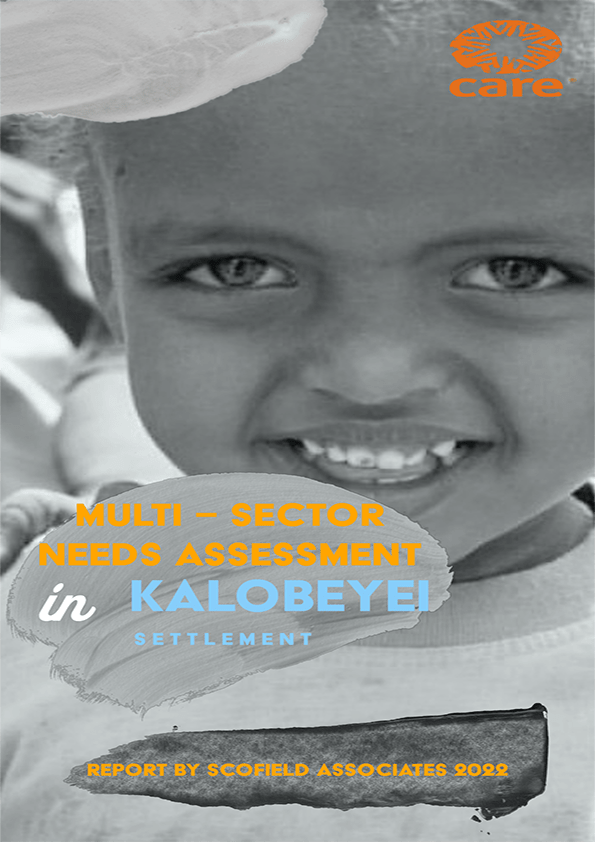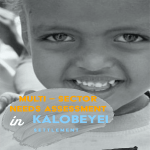
Multi Sector Needs Assessment Report - Kalobeyei Settlement, July 2022.
Reports
July 31, 2022
Executive Summary
The Executive Summary presents a comprehensive overview of the Kalobeyei integrated settlement, a relatively new refuge for migrants within Turkana County. This region consists of three distinct villages and currently houses 44,953 refugees and asylum seekers as of May 31, 2022 (UNHCR). The primary objective of this study was to delve into the intricacies of various sectors operating within the humanitarian context of Kalobeyei.
The research methodology employed a dual approach, combining the analysis of both secondary and primary data sources. Fieldwork was conducted from June 16 to June 26, 2022, utilizing a combination of quantitative and qualitative methods. The culmination of these efforts resulted in a comprehensive and complementary report, incorporating insights from household surveys, key informant interviews, and focus group discussions.
The demographic aspect of the study encompassed 443 households, with a distribution of 25.61% male and 19.82% female respondents. Furthermore, key informant interviews and focus group discussions involved a total of 36 participants. A notable revelation within the camp was the assertion by over half of the male respondents that they were the heads of their households, while acknowledging that women played a pivotal role as breadwinners. The newness of Kalobeyei as a settlement is reflected in the prevalence of unregistered refugees and asylum seekers, primarily due to a significant influx of newcomers.
The collaborative initiative spearheaded by UNHCR, the national government, and the county government of Turkana has played a crucial role in conferring refugee status, granting access to a spectrum of services provided by the Government of Kenya (GoK) across various sectors. Notably, based on the compiled data, Kalobeyei exhibited higher rankings than Kakuma in terms of access to healthcare services, food assistance, education, water and sanitation, protection, and employment, all averaging 9.1%. This trend underscores the success of the collaborative endeavor, aimed at establishing a more dignified and well-equipped settlement environment for refugees and asylum seekers.
Sectorial analyses unveiled notable improvements, particularly in the protection sector, evidenced by the existence of safe spaces within the camp and a reduction in insecure areas. Nevertheless, challenges persist for women and girls who encounter various forms of violence often embedded within traditional structures, leading to the victims not categorizing these actions as violence. The reporting of incidents in Kalobeyei reflects positive relations between authorities and refugees. However, the prompt handling of cases by the police remains an area that requires attention to maintain the existing harmonious relationships.
A pronounced need for infrastructural enhancements in the health and education sectors emerged as a primary concern. While schools are present, the availability of student equipment poses a challenge. It is evident from the findings that addressing these critical sectors has a direct impact on livelihoods, as improved facilities lead to reduced financial burdens on refugees.
The enduring impediment of the Covid-19 pandemic significantly affects refugees and asylum seekers in their pursuit of essential services. Delays in registration processes, exemplified by 8.6% in Village I and 1.6% in Village III, are attributed to pandemic-related disruptions. Conversely, effective messaging about the pandemic yielded positive results, with 21.8% taking mask-wearing seriously, and 0.6% opting to stay at home to mitigate risks.
Water scarcity remains a pressing challenge within the camp, underscoring the vital role of this resource. The analysis indicates that daily water consumption directly correlates with increased expenditure, impacting refugees’ financial situations. Specifically, the approximate daily cost of water in Village I is Ks. 38.23, compared to Ks. 9.12 in Village III. Additionally, 26.10% of refugees lack sufficient water containers, affecting the time required for water collection, as indicated by 26.09% of respondents.

Multi Sector Needs Assessment Report - Kalobeyei Settlement, July 2022.
Send download link to: